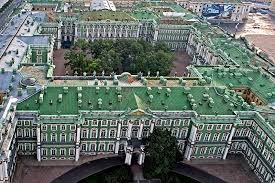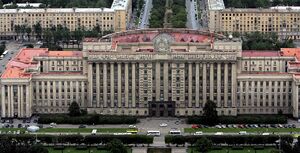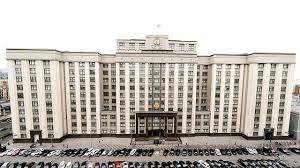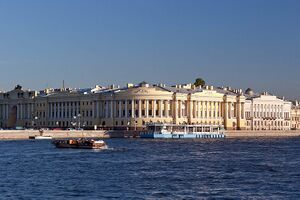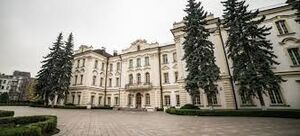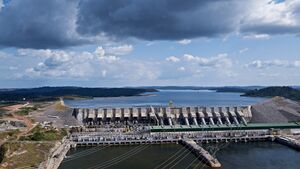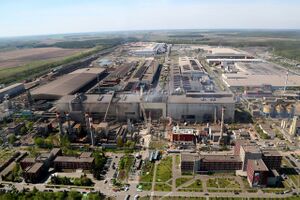Garindina
United Federation of Garindina Объединенная федерация Гариндины Об'єднана федерація Гаріндіна | |
|---|---|
Motto: Да здравствует Родина (Long live the motherland) | |
Anthem: National Anthem of Garindina | |
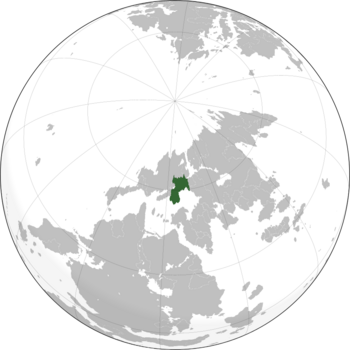 Map of Garindina | |
| Capital | Parsa |
| Largest city | Jasanasburg |
| Official languages | Garindinan |
| Recognised national languages | Yuzhstovan |
| Recognised regional languages | Koudish |
| Ethnic groups | 63% Garindinan 27% Yuzhstovan 5% Sepkoudiskfolkæ 3% Lakoudiskfolkæ 2% Doro |
| Religion | Garindinan Orthodox |
| Demonym(s) | Garindinan |
| Government | Federal Monarchy |
• Czarina | Nadia V |
• Speaker of the Assembly | Anatolii Zaytsev |
• Head Councilwoman | Natasha Ivanova |
• Prime Minister | Gregory Brezhnev |
| Legislature | Federal Assembly |
| Federal Council | |
| Council of Ministers | |
| Independant State | |
• The Garindinan Empire | December 20, 1350 - July 17, 1871 |
• The Constitution War | March 23, 1869 - July 17, 1871 |
• The October Coup | October 17, 1933 |
• The Garindinan Civil War | March 31, 1983 - September 2, 1998 |
| Area | |
• | 346,900 km2 (133,900 sq mi) |
| Population | |
• Estimate | 9,637,045 |
• Density | 0.026/km2 (0.1/sq mi) |
| GDP (nominal) | estimate |
• Total | 181.39 billion |
• Per capita | 18,700 |
| Currency | Grivna (Г̷̶̷ ) (GRV) |
| Time zone | UTC-4, UTC-3 |
| Date format | dd-mm-yyyy (AD) |
| Driving side | right |
| Calling code | +55 |
| Internet TLD | .gr |
This article or section is in the process of an expansion or major restructuring. You are welcome to assist in its construction by editing it as well. If this article or section has not been edited in several days, please remove this template. If you are the editor who added this template and you are actively editing, please be sure to replace this template with {{in use}} during the active editing session. Click on the link for template parameters to use.
This article was last edited by Definitely not a tree (talk | contribs) 10 months ago. (Update timer) |
Garindina, formally The United Federation of Garindina (Garindinan: Объединенная федерация Гариндины, Ob"yedinennaya federatsiya Garindiny, Yuzhstovan: Об'єднана федерація Гаріндіна, Ob'yednana federatsiya Harindina), is a sovereign nation in western Argis on Eurth. The country borders the Prymontian Rus to the North-East, and North Dniester and Ahrana to the east. Garindina has a coast with three bodies of water, these being the Canamo Sea, the Mediargic Sea, and the Sakspati Sea.
Garindina is classified as a Federal Monarchy. The political capital is Parsa and its largest city is Jasanasburg. The first civilization can be traced back to the Paras Gari in the 1st century BC. The head of state is Nadia V from the House of Yakolev. The Garindinan Civil War (1983-1998) has left clear scars on the people of Garindina and the nation, with a change of government and the return of the Garindinan Monarchy.
Today, Garindina has a mixed economy with low poverty rates due to the effects of the 1940 Right to Live Act. Garindina is a popular tourist destination with its many National parks and cultural activities. The nation has little more than 9.6 million people who call Garindina home.
Garindina is mostly a neutral nation. Despite this, Ómaksa Accords is a mutual defense pact in away as to protect Ómaksa from outside forces. Garindina is also a part of the AN, ATARA, and BFG.
Etymology
WIP
Geography
(Picture Gallery)
The geography of Garindina is quite diverse. With flat lowlands and vast grasslands in the south and rocky hills, mountains and vast forest in the north.
Climate
WIP
- Climate Map
Flora and Fauna
WIP
- picture gallery
Subdivisions
| Map | Flag and name | Capital | Governor |
|---|---|---|---|
| map | name | capital | governor |
History
WIP
- The first civilization can be traced back to the Paras Gari in the 1st century BC.
- The Garindinan Civil War (1983-1998) has left clear scars on the people of Garindina and the nation, with a change of government and the return of the Garindinan Monarchy.
- Today, Garindina has a mixed economy with low poverty rates due to the effects of the 1940 Right to Live Act.
- Ómaksa Accords (year?) is a mutual defense pact in away as to protect Ómaksa from outside forces. Garindina is also a part of the BFGG and…
Politics
Government
The Garindinan government can be very complicated and confusing at times. Garindina is an absolute monarchy, everything is run by the Crown, but there are three levels of government. These three levels are the monarchy, the central government (comprised of the Federal Council and the Council of Ministers), and the Supreme Court. The House of Ministries contains eight different Ministries and all decisions made by the Crown are enacted upon by the Council of Ministers, as they put the changes into effect. The Federal Council, on the other hand, governs the Oblast and Administrative Districts (ADs) of Garindina, all discussions still have to be approved by the crown. Local Government is appointed by the Federal Council, with no need for approval from the crown. The Supreme Court enforces all laws enacted upon by the Monarchy as well as protects the Garindinan Constitution, also known as the Nationalist Constitution.
Monarchy
The Monarchy of Garindina dates back to the first civilizations of the Gari people. Garindina is run by a hereditary monarchy and its current monarch is Queen Nadia V. The monarchy can be split into two sections, the Old Monarchy and the New Monarchy. This split is defined by the abolishment of the monarchy after the October Coup, currently Garindina is ruled by the new monarchy. The New Monarchy has ruled Garindina since 1998, after the end of the Garindinan Civil War. The first "New Monarch" was king Aleksandr the Great, and he reigned until his death on July 17th, 2015.
The Monarchs are Commander-in-Chief of the Garindinan Armed Forces and hold the authority to declare war and make alliances. Meaning that the entirety of the Garindinan Armed Forces and the Royal Guard are under the command of the Monarch. The Monarchy determines foreign policy and must sign all Acts, Bills and Laws for them to be enacted upon. Monarchs have the power to appoint Oblast and AD governors and the members of the Council of Ministers. The Monarch can also appoint the members of the Supreme Court, giving the Monarch absolute power over the Garindinan legal system. Not only that, but the Monarch also has direct control over the territories of Garindina.
Central Government
The Central Government of Garindina comprises two counsels, the Federal Council and the Council of Ministers. These two counsels make up the central body of the Garindinan government. These two counsels meet once a year at the Federal Assembly and discuss goals for the year.
Federal Council
The Federal Council governs the Oblast and Administrative Districts of Garindina. The Federal Council is made up of the Governors of Each Oblast and Administrative District, the current Head Councilman/women is Natasha Ivanova. Oblasts have the most autonomy in the Government, meaning they have the most power in the Federal Council. Administrative Districts have less autonomy, meaning they hold less power in the Federal Council.
Oblast were first introduced to Garindina after the Constitution War; this is due to the people of Garindina wanting representation in the government. Originally there were thirteen Oblasts, but after the Civil War, the Doria Oblast has been an independent nation. Each Oblast has its own form of government, all being a Federal Republic with their own State Duma. Despite this, the Oblast have no say in who will be the governor, as the monarch hand-picks all governors.
The same goes for Administrative Districts, they have their own State Council but have no say over who governs them. Administrative Districts are Politically important cities. With the Constitution only stating the six Administrative Districts of Parsa, Jasanasburg, Krasbograd, Novokamensk, Borisobay, and Yuzhemore. These Districts aren't just confined to a single city either, an Administrative District consists of the city in question and some surrounding area, with Novokamensk being the largest District.
Council of Ministers
The Council of Ministers comprises eight different ministries. With each minister being hand-picked by the monarch as well as the Prime Minister, who is in control of the council. Each minister controls their own sector of administration and put all decisions made by the Federal Council and the monarchy into effect depending on the sector. Ministers have the power to make decisions, but these decisions must be approved by the Monarch to be put into effect.
Ministries
| Name | Garindinan Name | Minister |
|---|---|---|
| Ministry of Agriculture | Министерство сельского хозяйства | Aleksandr Minsky |
| Ministry of Defence | Министерство обороны | Gedeon Molotov |
| Ministry of Education | Министерство образования | Sveta Zakharova |
| Ministry of Foreign Affairs | Министерство иностранных дел | Tatyana Kuzmina |
| Ministry of Health | Министерство здравоохранения | Klara Rostova |
| Ministry of National Security | Министерство Национальная безопасность | Konstantin Aleksandrov |
| Ministry of Transportation | Министерство транспорта | Dimitri Kuzan |
| Ministry of the Economy | Министерство экономики | Fedor Tarasov |
| Ministry of the Environment | Министерство окружающей среды | Ivan Rostovo |
Judicial
Supreme Court
The Supreme Court of the Garindinan United Federation is the supreme judicial body in civil, criminal and administrative cases, in cases regarding the resolution of economic disputes and other cases falling under the jurisdiction of courts. Established in the Garindinan United Federation in accordance with Federal Constitutional Law “On the Judicial System of the Garindinan United Federation”. The Garindinan Supreme Court ultimately protects the Garindinan Constitution and the rights of the people of Garindina.
The Court gets final say on any Laws and Amendments to the Constitution. It is headed by a five Judge Panel appointed by the monarch. Unlike other government institutions, the Judges have a twenty-year term. This can only be renewed once. All judges of the court must be politically neutral and unbiased during their terms.
Military Court
The Military Court is strictly for those who are in the Military, no civilian may be trialled in this Court. The Court is headed by the respected Commanding Officer of that Branch, with Two Law Degreed Military Judges. The verdict of this Court is final and cannot be overturned unless deemed a violation of Constitutional Right of the Person.
Military
The Armed Forces of Garindina is split into four different blocks. These four blocks are the Ground Force, Air Force, Navy, and Special Forces. Garindina practices conscription and mandatory military service, this means that every citizen of Garindina has to serve a mandatory ten-month service in the Garindinan Armed Forces. The age of conscription in Garindina is 21 years of age, but the mandatory ten-month military service must be served between the ages of 18-21. Garindina has a current 215,000 active professional military personnel and 147,000 reserve professional military personnel.
Enforcement
Federal Police
The Federal Police of Garindina are the main law enforcement body in Garindina. Each region has their own police offices headed by their own regional director. The Federal Police Services are responsible for the safety of all citizens, as well as all Government Issued Identification to all citizens.
Corruption
The Anti-Corruption Police (AKSP) is the newest police force in Garindina tasked with countering corruption in Garindina. The AKSP is a semi-independent police force that operates under the Monarchy. The AKSP, was established on May, 14, 2023, as part of the Garindinan Reformation. A series of reforms in Garindina repairing systems that were inefficient and only worsened the corruption within Garindina. The Reformation started the fight against corruption and began to fix these broken systems.
Economy
The Garindinan economy is a mixed economy, with government-controlled companies being common. The top three industries in Garindina are petroleum refinement, environmental tourism, and manufactureing. The Grivna is the national currency of Garindina and is also slightly inflated, making 1 Г̷̶̷ being equal to 1.8$. The minimum wage of Garindina is only 10 Г̷̶̷/hour with a national tax rate of 34%. With the entire economy of Garindina being worth an estimated 96 billion Grivnas.
Energy
Garindina has historically been a energy efficent country. Until around the 1960's, Garindina was run in coal plants. But after the passing of the 1964 Clean Air Act Garindina started to move away from coal plants. During the Garindinan Civil War, many coal plants were destroied, but the many Hydropower plants were left alone. As Garindina was still rebuilding, in 2005 King Aleksandr began to build wind and solar farms across Garindina, kickstarting the clean energy program. Slowly, Garindina began to move away from Coal and Oil. Today 75% of all energy production in Garindina is produced by renewable resources.
Energy mix in Garindina.
The Krylov Dam is one of the larger hydropower plants constructed, it is owned by the Canamo Canal Company headed in Prymont. Recently, Garindina has been looking into nuclear energy. The nuclear energy program has been protested by many do to concers of the ecological effects. Garindina has been an energy exporter in recent years. But with growing energy needs, Garindina might stop exporting energy.
As of now, 47% of Garindina's energy production is from Hydropower plants, with 18% from Coal, 17% from wind, 10% from Solar, and 8% from Oil.
Industry
Ever since the industral revolution, Garindina has mainliy had a manufacturing based economy. But as of recently, enviormental tourism has grown into one of Garindina's largest indusries, even passing manufacturing. Manufacturing is most prominate in the west of the country. Garindina can be divided into four main economic regions, manufacturing, petroleum refinement, tourism, and agriculture. These regions are not administrative but solely economic. Garindina has also been deilling and refining petrol since it's descovery in the Mediargic Sea in 1967.
In recent years, petroleum refinement has become the one of the largest industries in Garindina. WIP
Tourism
WIP (Pictured gallery of National Parks and Parsa, ie. Блэк-Хиллз National Park Black Hills.)
Demographics
Ethnicity
Ethnics diversity chart (2020)
Garindina is not an ethnically diverse nation. With a population of only 9.6 million, most of the people are either Garindinan or Yuzhstovan. There are small communities of other ethnic groups, but they only consist of 10% of the total population.
Religion
The freedom of religion is a guaranteed right in Garindina. Despite this, the national religion being Garindinan Orthodox. Garindinan Orthodox is the most prominent religion practiced in Garindina, with 5.2 million followers. In recent years, a growing number of people identify as irreligious. With three million people identifying as irreligious.
Culture
Garininan culture is quite unique compared to its neighbor of similar culture, the Prymontian Rus. This differentiation of cultures comes from the geography and history of Garindina. Garindinan traditions take roots from the Yuzh that originally lived in the Paras River Valley. For example, the celebration of Midsummer was origanally a Yuzhstovan celebration, now it's celebrated through out Garindina. Despite this, Garindinan culture is very unique.
Cuisine
WIP
Education
WIP
Language
WIP
Literature
WIP
Music
WIP
National Holidays
Garindina is a relatively festive nation, with seventeen holidays being celebrated nationwide. Twelve of these are religious and the rest being national. National Holidays are celebrated throughout the nation with a wide verity of activities depending on the day. During Midsummer celebrations, the most prominent celebrations are carnivals and dance. Whilst on Memorial Day, bonfires and memorials to honor the dead are held.
There are many lesser known Regional Holidays that are celebrated by their respected regions as well. These Regional Holidays are celebrated in their own ways that reflect the culture of the area. For example, The Festival of Lent is celebrated in the small coastal region of Sarata. This festival is only celebrated in this small region and marks the beginning of Lent.
List of National Holidays:
- New year celebrations: Dec 31-Jan 1
- The Czarina's birthday: March 22
- Midsummer: June 23-25
- Remembrance Day: July 17
- Federation Day: September 2
Sports
WIP


